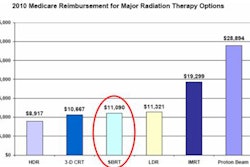Intensity-modulated radiation therapy (IMRT) reduces xerostomia, or dry mouth, in patients receiving the treatment for head and neck cancers, but it is unknown if the treatment is better or worse at reducing the size of tumors, according to a new comparative effectiveness review from the U.S. Agency for Healthcare Research and Quality (AHRQ).
The 144-page report, titled "Comparative Effectiveness and Safety of Radiotherapy Treatments for Head and Neck Cancer," indicates that fewer cases of xerostomia were associated with IMRT compared to conventional radiation therapy. However, researchers did not find evidence that IMRT is more successful than any other kind of radiation therapy in reducing tumors. The report was produced by the Blue Cross and Blue Shield Association's Technology Evaluation Center in Chicago.
The research team analyzed data from the past 20 years on treatment outcomes using IMRT, 2D radiation therapy, 3D conformal radiation therapy, and proton-beam therapy. The report examined treatment for cancers of the head and neck, including the mouth, larynx, and sinuses.
Acknowledging that proton-beam radiation therapy may target radiation even more precisely than IMRT, the researchers did not find enough evidence to draw any conclusions regarding its benefits or side effects. Proton-beam therapy is more commonly used to treat prostate cancer and pediatric tumors.
Nonbrain head and neck cancers account for up to 5% of cancers diagnosed in the U.S., with an estimated 47,560 new cases and 11,260 deaths in 2008.
Related Reading
Accelerated radiation therapy improves outcomes of head and neck cancers, April 9, 2010
Adverse effects common with chemoradiation for head and neck cancer, December 22, 2009
Protons promise lower second cancer risk, May 9, 2009
Amifostine reduces radiotherapy side effects, March 8, 2006
Copyright © 2010 AuntMinnie.com



















